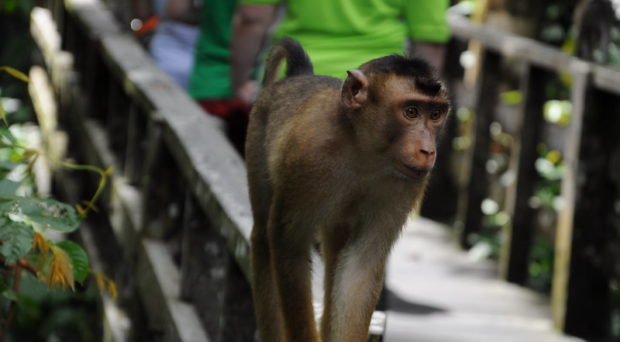
2017年,世界卫生组织东南亚地区致力于elimination of malaria by 2030。在这项重要的努力中,他们在控制人类疟疾方面取得了很大的成功。恶性疟原虫和P. vivax。Zoonotic malaria on the other hand, is harder to control and impossible to completely eliminate – here, sylvatic animals play unwilling hosts for these parasites, and transmission to humans rises as we continue to enter wildlife habitats. Additionally, cases can go undetected because communities in high-risk areas can bedifficult to reach, diagnose, and treat。
例如,马来西亚没有人类疟疾传播since 2018(尽管进口案件仍然是风险)。但是,有一个rise in zoonotic malariacaused byPlasmodium knowlesi在非人类灵长类动物中发现的,例如长尾猕猴;大约2600 cases were reported in 2020。In arecent paper,研究人员研究了居住在森林边缘的马来西亚土著人口的存档血液样本,并发现了其他五个猿猴疟疾的感染:P. cynomolgi,P. inui,P. coatneyi,P. inui-like, 和P. simiovale。
这些寄生虫have also been found来自柬埔寨,印度尼西亚,老挝,菲律宾,新加坡和泰国的猕猴。人类感染的报告continue to surface, highlighting the ongoing risk of zoonotic malaria.
What information are we missing?
Van de Straat及其同事在Malaria Journaltakes a look at our current knowledge of东南亚的动物疟疾媒介,专注于携带的蚊子P. Knowlesi。It is not a short list: nine species are, with varying degrees of evidence, involved in the transmission ofP. Knowlesiin the region (primarily from theAnophelesLeucosphyrus group). Or at least, nine that are known so far and about which some research has been published.

矢量的许多方面都会影响其在疾病传播中的相关性,例如它们的分布,尖峰咬合时间和孢子岩率。其他特征也很重要,因为它们可以帮助我们确定高风险区域或可能针对的控制,例如血液餐后的静止部位或发现幼虫的地方。尽管它们的重要性,但范德·斯特拉特(Van de Straat)及其同事发现P. Knowlesi许多这些指标几乎没有证据。According to the review, we know thatAnopheles dirus是森林和森林边缘居住,喜欢在傍晚咬咬,并在淡水池中繁殖。但是,我们不太确定休息的地方。一个。balabacensisprefers forest fringes and plantations, and bites mostly outdoors, but it’s uncertain where it rests or breeds. For many species, we don’t know much about their blood feeding behaviour or insecticide resistance status, information that is crucial for control programmes.
作者警告说,这是一个挑战,需要在未来的研究中紧急解决。
传输驱动程序
The review goes on to discuss studies that have found how the disturbance of sylvatic habitats through deforestation and agriculture affects the ecology of mosquito populations. One example of this is一个。balabacensis, which readily adapted its breeding sites in response to forest fragmentation和rubber plantations。Additionally, higher diversity and abundance of mosquitoes has been recorded沿着森林边缘,这可能导致疟疾传播增加。土地使用的变化还确定了哪些人口因蚊子叮咬和邻近灵长类的接触而面临风险 - 人类活动对猕猴的行为有直接影响,而猕猴的行为可以响应栖息地的碎片,可以通过寻求庇护来调整。around farmlands或寻找食物in human settlements。

Many factors make it challenging to control zoonotic malaria in Southeast Asia, such as the high biodiversity of vectors, increasing human expansion, and the difficulties in healthcare access for remote communities living in high-risk areas. As people continue to expand into sylvatic habitats, entomological monitoring remains key in the surveillance of zoonotic pathogens likeP. Knowlesi, especially in the context of anthropogenic land use: there is still a lot we don’t know about these mosquitoes and their adaptations to ecological disturbances. This increasing transmission of zoonotic malaria presents a threat to control and elimination programmes in the region.

注释